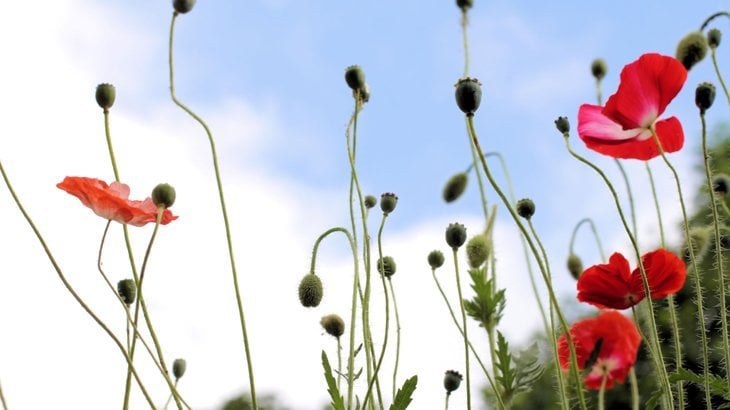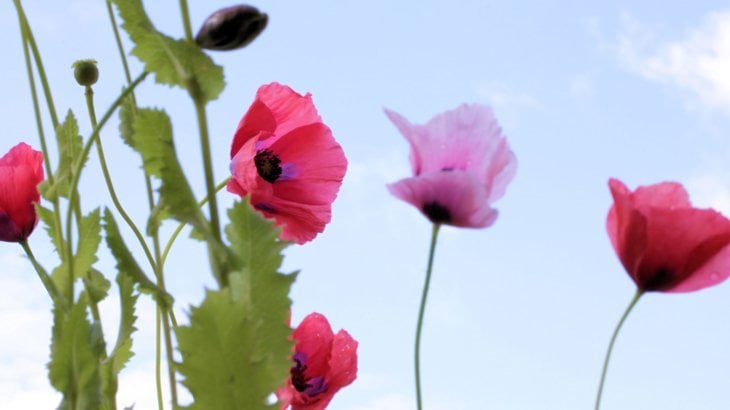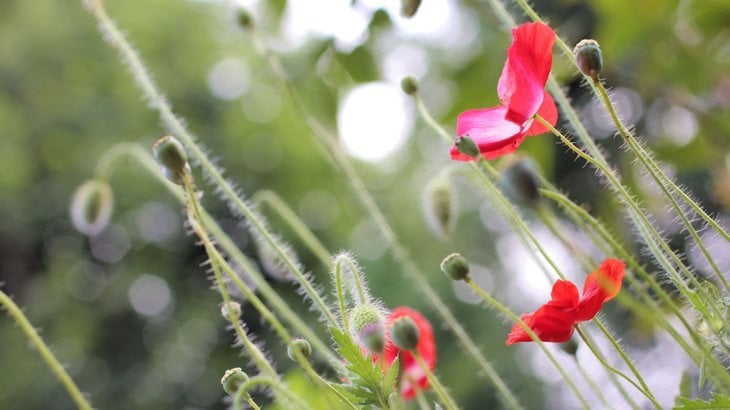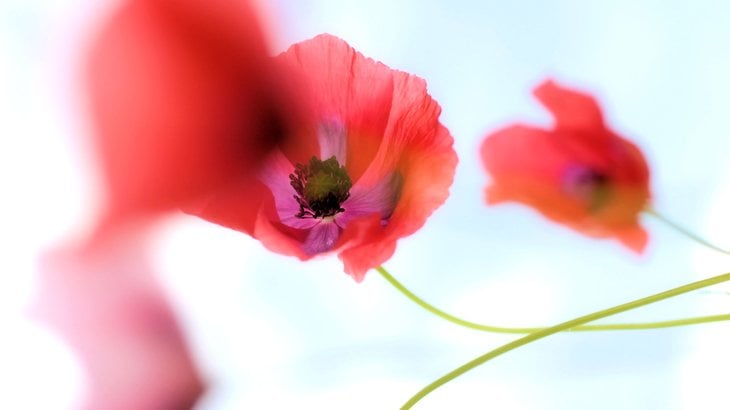Few flowers can stir the soul quite like the poppy. With its paper-thin petals and vibrant, cheerful blooms, a field of poppies is a sight that speaks of peace, of nature’s simple beauty, and of a lovely way to unwind from the world.
Yet, this delicate flower carries a weight of symbolism that belies its fragile appearance. It is a plant of profound duality: a symbol of sleep and peace in ancient myths, and the enduring emblem of war, sacrifice, and remembrance.

This article explores the poppy in all its facets—from the garden varieties that bring joy to hikers and homeowners, to the powerful story of how one species, the Flanders poppy, became an international symbol of the human cost of conflict.
A Guide to Common Poppy Varieties
While the red poppy of remembrance is the most famous, the poppy family is incredibly diverse, with around 250 species found across the globe. They are cherished by gardeners for their resilience and the dazzling bursts of color they bring to any landscape. Here are a few of the most common and beloved varieties.
Oriental Poppy (Papaver orientale)
A true garden showstopper, the Oriental Poppy is a long-lived perennial native to the Middle East. It is known for its huge, dramatic blooms that can reach 15 cm (6 inches) across, in stunning shades of scarlet, salmon, and pink.
Standing on stems up to 1.2 meters (4 feet) tall, they are a magnificent sight in late spring and early summer.
Flanders/Corn Poppy (Papaver rhoeas)
This is the iconic poppy of remembrance. An annual native to Europe and Asia, its brilliant scarlet flowers were the first to bloom on the battle-scarred fields of World War I.

It thrives in warmer climates and is the parent plant of the popular Shirley poppy hybrid, which comes in a wide range of colors.
California Poppy (Eschscholzia californica)
A vibrant, drought-tolerant wildflower native to the western United States, the California Poppy is the state flower of California.
Its bright orange, cup-shaped flowers open in the sunlight and close on cloudy days or at night. With its lacy, silvery-blue foliage, it’s a stunning addition to any dry, sunny garden.
Iceland Poppy (Papaver nudicaule)
Despite its name, this poppy is not from Iceland but is a hybridized group from sub-polar regions.
It is a short-lived perennial, often grown as an annual, that prefers cooler climates.
Its fragrant, delicate flowers come in beautiful shades of white, orange, and yellow, making it an excellent choice for cut flower arrangements.
Opium Poppy (Papaver somniferum)
Perhaps the most historically significant species, the Opium Poppy has a dual legacy.
It is the source of powerful medicinal alkaloids like morphine and codeine, but also provides the harmless, edible seeds used in baking and cooking.
Cultivated since ancient times, possibly by the Sumerians, this tall annual bears large purple, pink, or white flowers.

Table 1: A Comparative Guide to Common Poppy Varieties
|
Common Name |
Scientific Name |
Type |
Key Characteristics |
Ideal Growing Conditions |
|---|---|---|---|---|
|
Oriental Poppy |
Papaver orientale |
Perennial |
Large (15 cm) flowers in scarlet, pink, white; coarse green foliage; 1.2 m tall. |
Cool mountains with snowy winters; well-drained soil; USDA Zones 3-7. |
|
Flanders Poppy |
Papaver rhoeas |
Annual |
Scarlet-red flowers (5-10 cm) often with dark spots; delicate stems; up to 1 m tall. |
Warmer climates; mild, even chalky soils (pH 6.5−7.5); USDA Zones 4-9. |
|
California Poppy |
Eschscholzia californica |
Annual |
Bright orange/yellow cup-shaped flowers; lacy, blue-green foliage; drought-tolerant. |
Dry, sunny conditions; well-drained soil (pH 6.5−8.0); USDA Zones 6-10. |
|
Iceland Poppy |
Papaver nudicaule |
Short-lived Perennial |
Fragrant flowers in white, orange, yellow; green foliage; 30-60 cm tall. |
Cooler climates (night temps below 21°C); acidic soil (pH 6.0−7.0); USDA Zones 3-7. |
|
Opium Poppy |
Papaver somniferum |
Annual |
Large (13 cm) purple, pink, or white flowers; lobed silver-green foliage; up to 1.5 m tall. |
Temperate climates; fertile, well-drained soil. |

The Ancient History of the Poppy
Long before it was a symbol of war, the poppy was deeply woven into ancient culture, representing the powerful forces of sleep and death.
Poppies in Myth and Legend
In Greek and Roman mythology, poppies were associated with gods of sleep, such as Hypnos and Somnus.
The flower’s sedative properties, derived from the opium poppy, made it a fitting symbol for eternal sleep.
As such, poppies were often used as offerings to the dead and used as emblems on tombstones to symbolize a peaceful final rest.

Early Medicinal and Culinary Uses
The poppy’s practical uses are just as ancient. The Sumerians may have been the first to cultivate Papaver somniferum to harness its potent opium for medicinal purposes, using it as an analgesic and sedative.
At the same time, its tiny, ripe seeds were harvested as a nutritious food source, a practice that continues today in kitchens all over the world.

The Birth of a Symbol: The Flanders Poppy Story
The transformation of the poppy from an ancient symbol of sleep to a modern emblem of remembrance is a powerful story of war, poetry, and three remarkable individuals.
The Catalyst: John McCrae and ‘In Flanders Fields’
In the spring of 1915, during the brutal Second Battle of Ypres in Belgium, Canadian Lieutenant-Colonel John McCrae was serving as a military doctor.
Devastated after presiding over the funeral of a close friend, he observed how the churned-up, battle-scarred earth had given rise to fields of resilient red poppies.

Moved by the sight of this vivid red life blooming amidst the death and destruction, he penned the now-famous poem, In Flanders Fields .
In Flanders’ fields the poppies blow Between the crosses, row on row, That mark our place: and in the sky The larks, still bravely singing, fly Scarce heard amid the guns below.
We are the dead. Short days ago We lived, felt dawn, saw sunset glow, Loved and were loved, and now we lie In Flanders’ fields.
Take up our quarrel with the foe; To you from failing hands we throw The torch; be yours to hold it high, If ye break faith with us who die We shall not sleep, though poppies grow In Flanders’ fields.

The American Champion: Moina Michael’s Vow
Across the Atlantic, an American professor named Moina Michael read McCrae’s poem just before the end of the war in 1918.
Deeply moved, she wrote a poem in response called “We Shall Keep the Faith” and made a personal vow to always wear a red poppy as a symbol of remembrance for the soldiers who had sacrificed their lives.
She began a tireless campaign to have the poppy adopted as a national symbol of remembrance in the United States, establishing it as a personal token of memory.

The Global Movement: Anna Guérin’s Mission
The idea became an international phenomenon thanks to a Frenchwoman named Anna Guérin.
After meeting Moina Michael, she conceived of manufacturing and selling artificial poppies to raise money for veterans, widows, and orphans devastated by the war.
It was her relentless promotion that brought the poppy to Great Britain, where the British Legion adopted it in 1921, and to other Allied nations like Australia and Canada.
She cemented the poppy not only as a symbol of remembrance but as a powerful tool for supporting the living.
The Poppy Today: A Lasting Legacy
Today, the red poppy remains an enduring symbol of the human cost of war. Each November, millions of people pin a poppy to their lapel for Remembrance Day to honor those who have fallen in conflicts past and present.
In its strange mixture of fragility and resilience, the poppy perfectly reflects the human spirit.
It is a cheerful bloom that can brighten any garden, and a solemn reminder of a debt that can never be repaid—a beautiful flower with a story that should never be forgotten.









Did you know to keep poppies like these you have to spray with water last thing at night or first thing in morning. If left in a vase of water they just die. Something to do with the fine hairs
My favourite flower done justice with beautiful pictures and descriptions ,thank you 🙂
Thank you so much for your comments. Poppies really do inspire emotions don’t they?…
the pictures speak as much as the spoken words written; you are gifted in both as much as you are unselfish. thanks for sharing these with the rest of world.
Love poppies.. I started mine in the Los Padres National Forest from seeds in a neighbors yard, now they are perennial and reseed themselves in the most rocky, unfriendly decomposing granite soil. Bright and beautiful…
Wow Paul, just exquisite! Love the images.
Ann
🙂 Thanks
“Calma e relaxa!” Obrigado!!!
Lindas imagens!!! Vou dizer feliz! 🙂
:)))Thanks
These are so beautiful!! You make us really want to stop and smell the poppies.
Thanks for the kind comment Charu 🙂